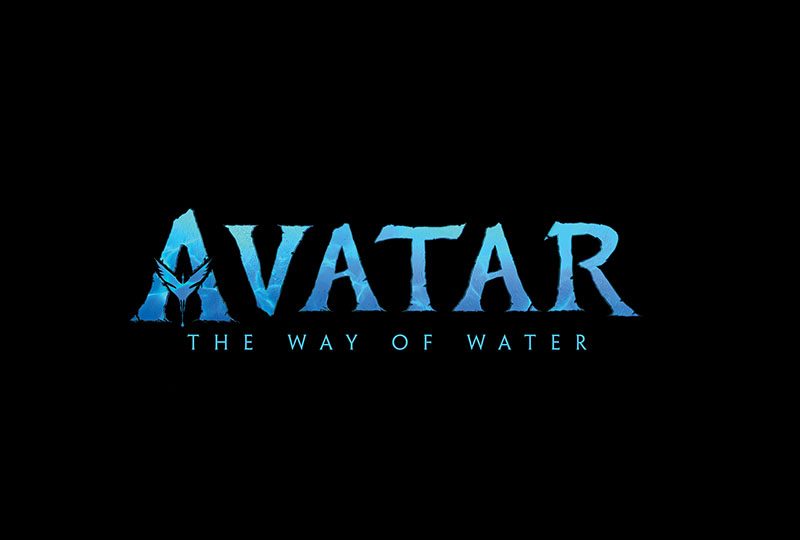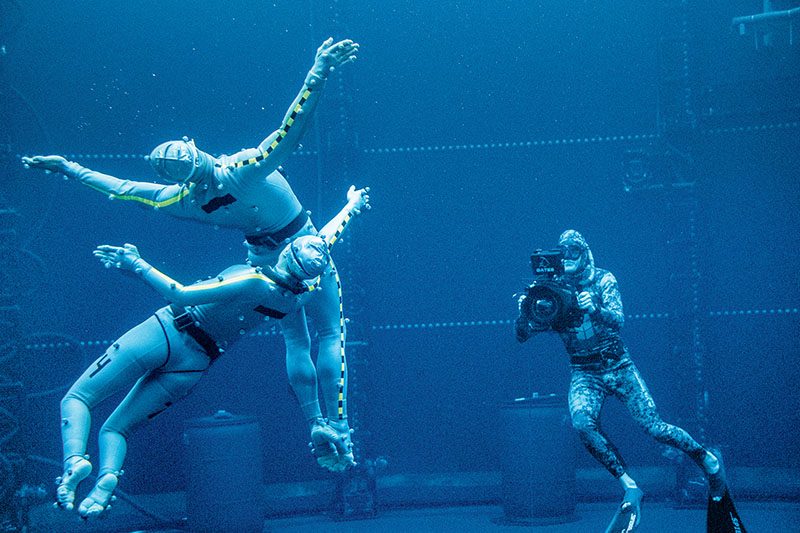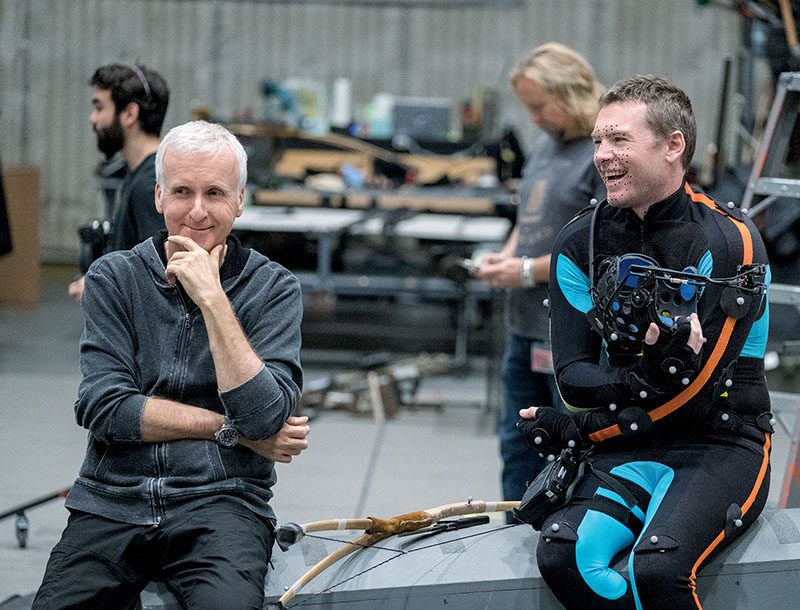Upon its release in December 2022, Avatar: The Way of Water drew huge attention from the dive community for its remarkable underwater scenes. Curious to delve into the behind-the-scenes story of what it took to achieve the technical mastery those scenes displayed, I chatted with producer Jon Landau, freedive instructor Kirk Krack, director of underwater photography Pete Zuccarini, and supervising master diver and safety officer John Garvin.
The sequel to 2009’s Avatar introduces the Metkayina, Na’vi who are born in the ocean and have adaptations such as tails shaped to help enhance in-water propulsion and eyes that provide better underwater vision. They move through the water much like freedivers without fins. The in-water skills the Metkayina characters demonstrate are rooted in hydrodynamics. Landau explained this quest for authenticity in greater detail.

What was the thought process that went into making an extensively underwater film?
Jon Landau: The first thought was the story. Going into the sequel, we saw the ocean as a transportive journey for our audience to go to the incredible places you’ve been to or that I’ve been lucky enough to dive, and for sure those Jim Cameron has explored. Pandora is a world with water, like Earth. Not all of this film is underwater, of course, but as we saw from the first movie’s fantastical forest and floating islands, there is also a great deal of joy and wonder in the oceans of Pandora.
Think about when you swim around a reef structure and suddenly see a manta ray or a whale shark. You’re amazed! We wanted to take what ocean life has shown us and stand it on its tail. We know from experience what a sperm whale looks like underwater, and we wanted our whale variants, the tulkun, to grow to 300 feet (91 meters) long and have amazing new functionalities and a spiritual relationship with the Metkayina. That was the kind of ocean environment we envisioned.
I saw that in your coral reef. The fish were generally similar to fish we see on Earth, as if they had some distant relation to jacks, butterflyfish, and jellyfish. We saw the basic forms of sharks, whales, eels, and even a flying fish, but clearly different. This isn’t your first splash into underwater films. Jim made The Abyss in 1989, and you and he collaborated on Titanic in 1997. There was a lot of water work in that one.
Yes, but this one has something Titanic did not: breath-hold diving! When Jim approached Sigourney Weaver to do this movie, he told her she needed to be able to hold her breath for three minutes to do a scene. She said, “Jim, I can’t hold my breath for 30 seconds.” Yet eventually she could do much more than that, working her way up to five minutes of static apnea.
You’ve seen movies that are dry-for-wet; Aquaman is an example. The underwater scenes are typically simulations in front of a green screen, and performers levitate on cables to approximate what they might look like moving within an environment more than 800 times denser than air. Wind machines blow their hair, and computer-generated imagery techniques are added during postproduction. That was not good enough for Jim. He wanted the authenticity of wet-for-wet, which meant that everyone — actors and camera crew — had to be skilled freedivers.
The technology has been around long enough that your readers probably know something about performance capture. You likely recognize the round beads sewn on suits in behind-the-scenes shots from Avatar or other movies. But now the reflective marker dots would be on wetsuits, and the underwater cameras can’t really differentiate between a marker on an actor’s suit or an exhaust bubble from a scuba regulator.
As Jim explained it, “Everybody who was working in the tank was holding their breath. If there was someone down there holding a light, they were holding their breath. If they were operating a camera, they were holding their breath. The actors, of course, had to be holding their breath.” That bit of physics — the inability to differentiate between a performance-capture suit marker and an exhaust bubble — is why Avatar: The Way of Water had to be a freediving film.

Training Actors and Crew
To better understand the freedive aspect of the film, I interviewed Kirk Krack, founder of Performance Freediving International. For the past five years he has been intimately involved in establishing protocols and instructing cast and crew to operate at the high levels of breath-hold efficiency required for this film.
I learned about the huge tanks you were using for filming. The tank at production company Lightstorm Entertainment’s Manhattan Beach, California, studio was 120 feet (36,6 meters) long, 60 feet (18 meters) wide, and 30 feet (9 meters) deep. It held more than 250,000 gallons (946.353 litres) of water and could simulate waves breaking on the shore. That was just one of the six tanks, so this film had significant in-water infrastructure. I understand why bubbles were an issue for the wet-to-wet film technique, but couldn’t rebreathers have worked as well?
Kirk Krack: In shallow water, rebreathers aren’t necessarily totally bubble-free. Even more important, the Metkayina have evolved for life in the sea, so they needed to move like freedivers. The underwater “volume” (the name for performance-capture stages) was a huge tank with 200 cameras mounted at three levels plus the cameras that Pete Zuccarini and the assistant camera operators were shooting. We couldn’t have some people on scuba, some on rebreathers, and some freediving. With that as the prerequisite, we had to consider what it would take to make everyone in the tank into freedivers.
I saw it as a two-pronged approach. We’d have to start with a training regimen to make the cast, crew, and camera operators into freedivers if they weren’t already, and if they were, make sure they would follow the same protocols as our new freedivers. Once we were filming, we utilized technical freediving to enhance performance capabilities. At times, people in the tank might be prebreathing 50 or 80 percent nitrox before their freedive performances. Being on the set made everyone appreciate the cutting-edge technology necessary to bring the ideas to fruition.


I read about the technology in the production notes. Cameron said his virtual camera integrated the two performance-capture volumes (air and underwater) in real time.
The virtual camera was especially mind-boggling. You had all these cameras filming people with marker dots moving in a tank, yet on the topside monitor we saw them swimming in the surreal Pandoran sea in real time. It was a unique form of moviemaking. I predict the upcoming film awards season will fully recognize this film’s degree of technical achievement.
There was something special about this project. Cameron’s demands for perfection meant we had time and motivation to thoroughly train the people involved. Some of the cast and crew were water savvy, but some were almost afraid of the water. We had the luxury of concentrating on freediving theory, water safety, and technique. We had to make them such good freedivers they could go beyond merely holding their breath. They couldn’t look like they were trying to survive; they had to be able to act.
It was quite challenging for me and the stunt performers. I often did more than three hours of breath-hold diving in a 12-hour workday. At 6 a.m. I might be up vacuuming the tank, and at the end of the day we’d blend the nitrox for the next shoot day. We had up to 30 people in the water at once and logged more than 250,000 freedives on this movie. All the actors could do more than four minutes in static apnea, and Kate Winslet could do more than seven minutes!
How did that work practically? Was everyone on the surface waiting for Jim to call “action,” and then you all dived to shoot?
No, it was exactly the opposite. All 200 people working on the scene would be waiting on us. Our freedive performance was the linchpin. We’d count down to our signal to dive after we’d prebreathed and established comfort level for performing. We used technical freediving with nitrox to reduce hypoxia risk, recover more rapidly, and become comfortable enough with the in-water experience to act.
Filming Freedivers
When a big-budget Hollywood film needs an underwater cameraperson, Pete Zuccarini is likely to be called into action. It was no surprise that Zuccarini was involved when Cameron was recruiting the top talent for this project. It no doubt helped that he is a talented freediver. Even though the performance capture for Avatar: The Way of Water commenced in September 2017 and ran for roughly 18 months, Zuccarini joined the project in April 2017.
Typical of the preparation that goes into a James Cameron production, Zuccarini was called to shoot tests in different environments, including San Pedro Harbor, Catalina Island, and the Bahamas. In the Bahamas they filmed record-setting freediver William Trubridge freediving without fins so they could study and consider his technique.


It seems like there are scenes in the movie that someone who isn’t a diver and hadn’t seen such an interplay of light somewhere beneath the sea couldn’t have scripted. James Cameron, in particular, has apparently been diving with a different objective over the years, for I see decades of studying light underwater in every frame.
Pete Zuccarini: The interplay of light at different depths and sea states was actually scripted. During our open-ocean tests in the Bahamas, Jim asked me to shoot very specific elements in 8K at high frame rates. We studied how the light filtered down through the water column under large ocean swells, windy choppy surfaces, and glassy smooth surfaces. We captured the qualities of light dispersing through particles and how the refractive patterns play on the benthic substrate at different depths.
The visual effects team pretty well understood the filtering of color wavelengths at different depths, so we were going after more subtle physics details, such as the way sand was twirling off the tops of the ripples in the sand under the waves. We looked at how swell and turbulence moves things such as hair, clothing, skin, and seagrasses. These high-resolution real ocean images provided reference data to better inform and communicate with the visual effects team responsible for creating Pandora’s ocean.
To experience the feeling of riding a large, powerful aquatic animal in the open ocean, the stunt team created mechanical proxies of the tulkun, ilu, and skimwing. These mechanical creatures were towed by boats or powered by a proprietary jet-propelled apparatus to simulate the movement and maneuverability of the creatures you see in the movie.
An underwater stunt “driver” and another stunt performer would hang on rodeo-style at incredibly high speeds. The velocity of the rapid ascents and descents required the stunt team to accomplish unprecedented feats of breath-holds, equalization, and strength. Imagine riding a creature with enough inertia to go from underwater, jump 12 feet (3,6 meters) out of the water, and then descend in seconds to a depth of 40 feet (12 meters). All the while the stunt performers were doing hand signals and facial expressions to remain in character while traveling 5 knots underwater.
Jim wanted reference cameras to record every moment of these runs from multiple angles. In addition to attaching action cameras to the creatures and stunt people, we set up two extremely fast diver propulsion vehicles (DPVs) to track along with the action. I operated in tandem with Charlie Arneson to stay with the action underwater. These camera sleds were fast enough to require a cowling to keep our dive masks from being ripped off of our faces.
I used a special nose clip that allowed me to equalize my ears and mask hands-free. The need to follow the subject through the rapid ascents and to remain streamlined and agile dictated that we operate as freedivers. From these tests, Jim fine-tuned what he wanted to see in the design and utilization of the performance-capture tank Lightstorm built at Manhattan Beach Studios.


Supervising Safety
One of the most important people on this film was John Garvin, who oversaw the tens of thousands of scuba dives and hundreds of thousands of freedives over the four years of shooting. Up to 30 divers — stunt performers, grips, lighting technicians, camera operators, safety divers, and actors — could be working in the tank at any given time. The work was often spread among a dozen different dive teams in a rapidly changing environment. No one got hurt on the production, which says a lot about Garvin’s professionalism and commitment.
What you had to do sounds like a daunting challenge. How did you go about it?
John Garvin: My first task was to write our dive safety operations manual. We had to define the hazards and mitigate them. The lighting department had to move up and down through the water column, so we adapted the Tasmanian Bounce Diving Tables for our nitrox mixes. We had dive computers on every wrist, and while decompression sickness was not our first concern, it could happen with spending up to 12 hours a day in the water. Each production tank had specific emergency drills based on its characteristics.
We also consulted with the top experts in their specialty fields, such as Neal Pollock, PhD, and Simon Mitchell, MB ChB, PhD. Another tenet of our approach was learning from our mistakes along the way. We never had any shallow-water blackouts, but we had a loss of motor control at the surface early in the process. That incident told us that prebreathing nitrox was necessary. Our baseline goal was a two-minute working breath-hold for each actor, which we surpassed. The Metkayina are born in the water, so the other critical goal was for all the actors to look comfortable underwater, as if they were water-born as well.
Was there any specific tank hazard that kept you up at night, wondering how to mitigate it?
The diffusion balls that floated on the surface caused me a lot of anxiety. While they were the perfect size for light transmission and allowing the diver to punch through to the air, they were also perfectly trachea sized. Not only did divers have to get to the surface, but they also had to raise their heads through the 3-inch (7,6 centimeters) blanket of these balls to get a breath. We prepared safety protocols in case of ingestion. For all the high-tech innovations on this film, a $2 pool noodle for the actors to rest on at the surface was what we all depended upon.
How did you communicate underwater? I can’t imagine hand signals were enough for a project this complex.
I give a huge shoutout to Ocean Technology Systems. The set was quite noisy underwater, yet everyone had to follow their team’s directions. That meant operating on different channels with multiple hydrophones and noise gates. The grips had to constantly talk to each other to do their job, for example, but the actors needed to hear Jim.
His communication with the actors was invaluable because Jim is a tremendously experienced diver. He knows that water dictates movement. You can’t fake that. Even nondivers in the audience will intuitively pick up on underwater physicality that isn’t right for some reason, which then severs the emotional attachment. That’s why this film is wet-for-wet. We hope it will resonate with anyone who deeply loves the ocean, but it will be particularly relatable to divers.
We did everything underwater that you see underwater in this film. The team came to understand the technical challenges of bringing James Cameron’s vision of underwater Pandora to life. Yet, as Landau pointed out, while the ocean provided the backdrop to tell the story, the story was still paramount. Our job was to collaborate with Jim, the entire crew, and the actors to bring the underwater visuals of that story to life.
Explore More
Learn more about the making of Avatar: The Way of Water in these videos.
© Alert Diver — Q1 2023